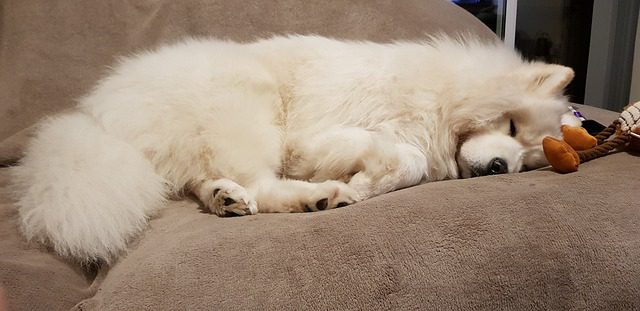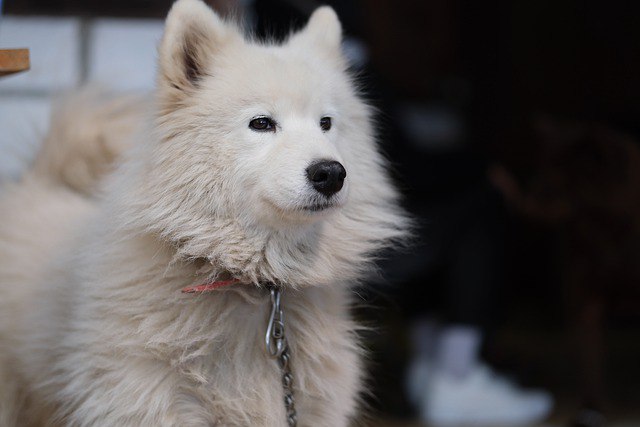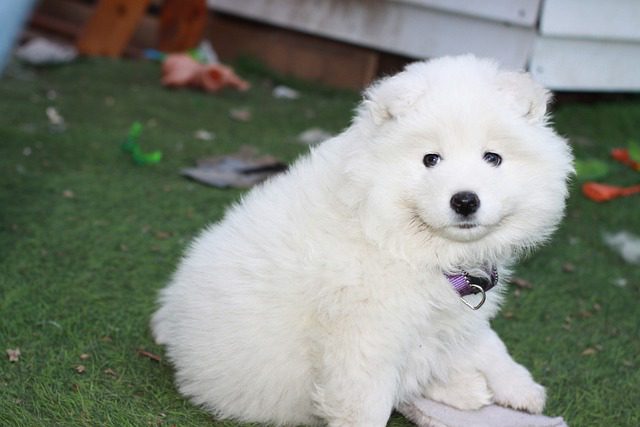Today, let’s dive into the heartwarming world of Samoyed dogs and a common challenge they face: Samoyed separation anxiety.
If you’ve ever witnessed those soulful eyes pleading with you not to leave, or come home to a scene of destruction, this blog post is for you.
We’ll explore the causes, symptoms, and practical tips to help your Samoyed conquer separation anxiety and thrive when you’re not around.
So, please grab a cup of tea, and let’s get started!
What is Separation Anxiety in Samoyeds?
Separation anxiety in Samoyeds refers to a condition where these dogs experience distress and anxiety when they are separated from their owners or left alone.
Symptoms of separation anxiety in Samoyeds may include excessive barking, destructive behavior, house soiling, pacing, and attempts to escape.
Causes of separation anxiety can vary and may include changes in routine, previous traumatic experiences, or a lack of proper socialization.
Treatment for separation anxiety in Samoyeds often involves behavior modification techniques, such as desensitization and counterconditioning, as well as providing mental and physical stimulation to alleviate anxiety.
Samoyed separation anxiety symptoms

Here are some common symptoms of Samoyed separation anxiety:
1. Accidents in the house: Dogs with separation anxiety may exhibit inappropriate elimination indoors, even if they are typically house-trained. This behavior is often a result of anxiety and stress caused by being separated from their owners. The dog may urinate or defecate in various areas of the house, such as on carpets, furniture, or beds.
2. Excessive salivation, drooling, or panting: When Samoyeds experience separation anxiety, they may exhibit increased salivation, excessive drooling, or excessive panting. These physiological responses are signs of stress and anxiety. The dog’s mouth may become wet, and they may leave noticeable saliva marks on floors or furniture.
3. Desperate attempts to escape confinement: Dogs with separation anxiety may engage in frantic and persistent attempts to escape from their confinement areas, such as crates or rooms. They may scratch at doors or windows, chew on furniture or other objects, or even injure themselves in their desperate efforts to reunite with their owners. This behavior is a manifestation of their distress and the overwhelming desire to be near their loved ones.
4. Whimpering, howling, barking, or crying: Vocalization is a common symptom of separation anxiety in Samoyeds. They may vocalize excessively, expressing their distress through whimpering, howling, barking, or crying. These sounds can be continuous or intermittent, and they often occur when the dog is left alone or detects the approaching departure of their owners.
5. Pacing and restlessness: Restlessness is another common sign of separation anxiety. Samoyeds may exhibit pacing back and forth, often near exits such as doors or windows. This behavior reflects their agitation and the desire to find their owners. They may also engage in repetitive behaviors like spinning or circling in response to their anxiety.
6. Decreased appetite: Some Samoyeds with separation anxiety may experience a decreased or complete loss of appetite when they are apart from their owners. They may refuse to eat even their favorite treats. This loss of appetite is a result of the stress and anxiety they feel during separation and can lead to weight loss and other health issues if not addressed.
Causes of separation anxiety in Samoyed

While the specific causes of separation anxiety can vary from dog to dog, here are some factors that can contribute to separation anxiety in Samoyeds:
1. Lack of socialization: Samoyeds are highly social dogs that thrive on human companionship. If they are not adequately socialized during their early development stages, they may become overly dependent on their owners. This dependence can lead to separation anxiety when they are left alone.
2. Sudden changes in routine: Samoyeds are creatures of habit and thrive on a predictable routine. Any sudden changes in their daily routine, such as a change in work schedule, moving to a new home, or the absence of a family member, can trigger separation anxiety. Samoyeds may become anxious and stressed when they are not sure what to expect.
3. Previous traumatic experiences: Dogs that have experienced traumatic events in the past, such as being abandoned, neglected, or spending time in a shelter, may be more prone to developing separation anxiety. These experiences can create a fear of being left alone and trigger anxiety when separated from their owners.
4. Lack of mental and physical stimulation: Samoyeds are intelligent and active dogs that require both mental and physical stimulation to stay happy and balanced. If they do not receive enough exercise, playtime, or mental enrichment, they may become bored and anxious when left alone. A lack of stimulation can contribute to the development of separation anxiety.
5. Over-attachment to owners: Samoyeds are known for their strong bond with their owners. While this is often seen as a positive trait, an excessive attachment can lead to separation anxiety. If a Samoyed becomes overly reliant on their owner’s presence and struggles to cope with being alone, they may exhibit signs of separation anxiety.
6. Lack of Proper Crate Training: Inadequate crate training during puppyhood can contribute to separation anxiety in Samoyeds. Proper crate training helps dogs feel secure and comfortable when left alone. Without this training, dogs may feel anxious or stressed when confined to a crate or left alone in the house.
Addressing Samoyed Separation Anxiety

Here are some of the most common ways of addressing and managing Samoyed separation anxiety:
1. Gradual desensitization: Gradual desensitization involves exposing your Samoyed to being alone for short periods and gradually increasing the duration over time. Start by leaving your Samoyed alone for just a few minutes and gradually extend the time as they become more comfortable. This process helps them build confidence and reduces anxiety by gradually teaching them that being alone is not a threat.
2. Counter-conditioning: Counter-conditioning aims to change your Samoyed’s emotional response to being alone. Associate positive experiences with being alone by providing treats, toys, or puzzles that can keep them engaged and distracted while you’re away. For example, give them a special treat or a puzzle toy filled with their favorite food just before you leave. This helps create a positive association with your departure and can help alleviate anxiety.
3. Create a safe space: Provide a comfortable and secure area for your Samoyed when you’re not at home. This can be a crate or a designated room with their bed, toys, and familiar scents. The safe space should be an area where your Samoyed feels safe and relaxed. Gradually introduce them to this space by making it a positive and rewarding environment. Use treats, toys, and positive reinforcement to make it a place they enjoy being in.
4. Establish a routine: Dogs thrive on routine, and having a consistent daily routine can help reduce anxiety and provide a sense of security for your Samoyed. Stick to a schedule that includes regular exercise, feeding, and playtime. A tired and mentally stimulated dog is more likely to be calm and relaxed when left alone. A routine also helps your Samoyed know what to expect, which can reduce anxiety.
5. Leave calming stimuli: Leave calming music or white noise playing in the background to help soothe your Samoyed while you’re away. Calming music specifically designed for dogs can have a relaxing effect and drown out external noises that may trigger anxiety. The continuous sound can create a soothing environment and help your Samoyed feel more secure.
6. Use pheromone products: Pheromone diffusers or sprays mimic the natural calming scents produced by mother dogs. These products can help reduce anxiety in Samoyeds by creating a familiar and comforting environment. Pheromone products are available in pet stores and can be used in a designated safe space or sprayed on a bandana or bedding.
7. Interactive Toys: Interactive toys or treat-dispensing toys can be a great way to keep your Samoyed mentally stimulated and occupied while you’re away. These toys can provide a distraction and help alleviate boredom and anxiety. Fill the toys with treats or food, which will keep your dog engaged and focused on the toy rather than their anxiety.
8. Avoid Reinforcing Anxiety: It’s important to avoid reinforcing anxious behavior in your Samoyed. When leaving or returning home, keep departures and arrivals low-key. Avoid making a big fuss or displaying excessive emotion, as this can reinforce your dog’s anxiety. Instead, practice a calm and consistent routine, which helps your Samoyed understand that these events are not a cause for concern.
9. Regular Exercise: Regular exercise is crucial for a Samoyed’s overall well-being and can significantly help in reducing separation anxiety. Make sure your Samoyed gets enough physical exercise through activities like walks, runs, or playtime. Mental stimulation is equally essential, so engage in training sessions or interactive games to keep their minds occupied. A tired dog is less likely to experience anxiety when left alone.
10. Seek professional help: If your Samoyed’s separation anxiety persists or worsens despite your efforts, it’s essential to seek professional help. A professional dog trainer or a veterinary behaviorist can assess your Samoyed’s specific needs and provide guidance and personalized treatment plans. They can help identify any underlying issues and develop a comprehensive approach to address separation anxiety.
11. Medication: In severe cases where other methods have been ineffective, medication prescribed by a veterinarian may be necessary to help manage your Samoyed’s anxiety. Medication should always be used under the guidance of a professional and in conjunction with behavior modification techniques. It’s crucial to consult with a veterinarian who specializes in behavior to determine the appropriate medication and dosage for your Samoyed.
Frequently Asked Questions
Why do Samoyeds develop separation anxiety?
Samoyeds are known for their strong bond with their owners and their social nature. They thrive on companionship and can feel anxious when left alone for extended periods. Factors such as a change in routine, a new environment, or a traumatic experience can contribute to the development of separation anxiety in Samoyeds.
How can I prevent separation anxiety in my Samoyed?
To prevent separation anxiety in your Samoyed, it’s essential to gradually acclimate them to being alone. Start by leaving them alone for short periods and gradually increase the duration. Provide them with plenty of mental and physical stimulation before leaving, such as interactive toys or puzzle feeders. Creating a safe and comfortable space for them, with familiar smells and their favorite toys, can also help alleviate anxiety.
Can training help with Samoyed separation anxiety?
Yes, training can be beneficial in managing Samoyed separation anxiety. Positive reinforcement-based training techniques can help your Samoyed associate being alone with positive experiences. Teaching them cues like “stay” and “settle” can also help them feel more secure and relaxed when you’re not around. Seeking guidance from a professional dog trainer specialized in separation anxiety can provide you with effective strategies tailored to your Samoyed’s needs.
Are there any medications or supplements for Samoyed separation anxiety?
In severe cases, your veterinarian may recommend medications or supplements to help manage your Samoyed’s separation anxiety. These may include anti-anxiety medications or natural supplements that promote relaxation. However, it’s crucial to consult with your vet before considering any medication, as they can guide you on the appropriate dosage and potential side effects.
Can getting another dog help with Samoyed separation anxiety?
Introducing another dog into the household is not a guaranteed solution for Samoyed separation anxiety. While some dogs may find comfort in the presence of a companion, it’s important to assess each dog’s needs and temperament. Proper introductions and compatibility between the dogs are crucial. It’s best to consult with a professional dog behaviorist to determine if getting another dog is a suitable solution for your Samoyed’s separation anxiety.
Conclusion
In conclusion, when it comes to Samoyed separation anxiety, understanding is key. Remember, these fluffy companions thrive on love, attention, and consistent routines. By providing them with the reassurance they need and implementing positive training techniques, we can help alleviate their anxiety and create a harmonious bond that lasts a lifetime. So, let’s shower our Samoyeds with love and watch their anxiety melt away!


